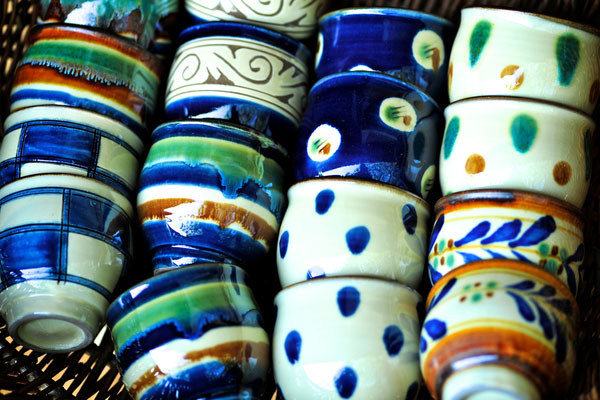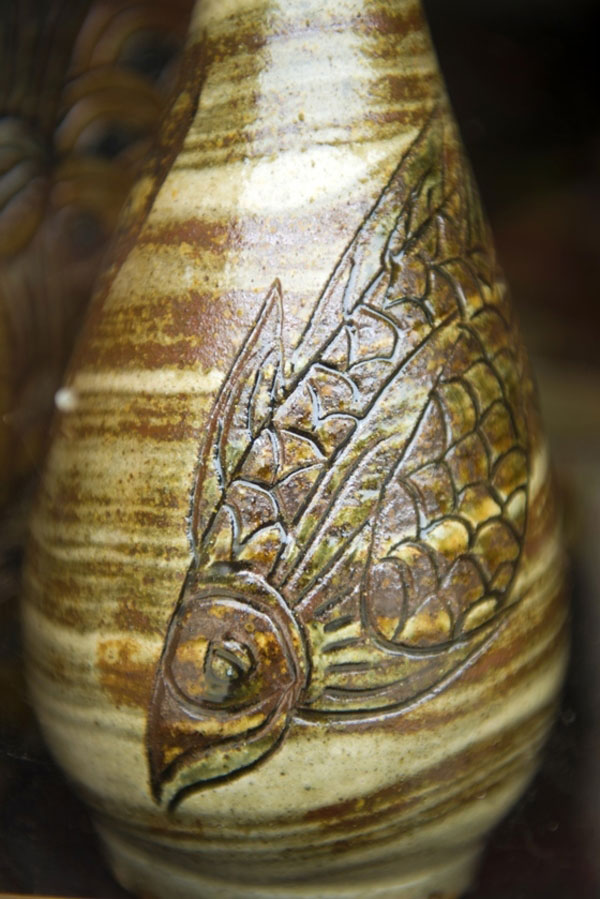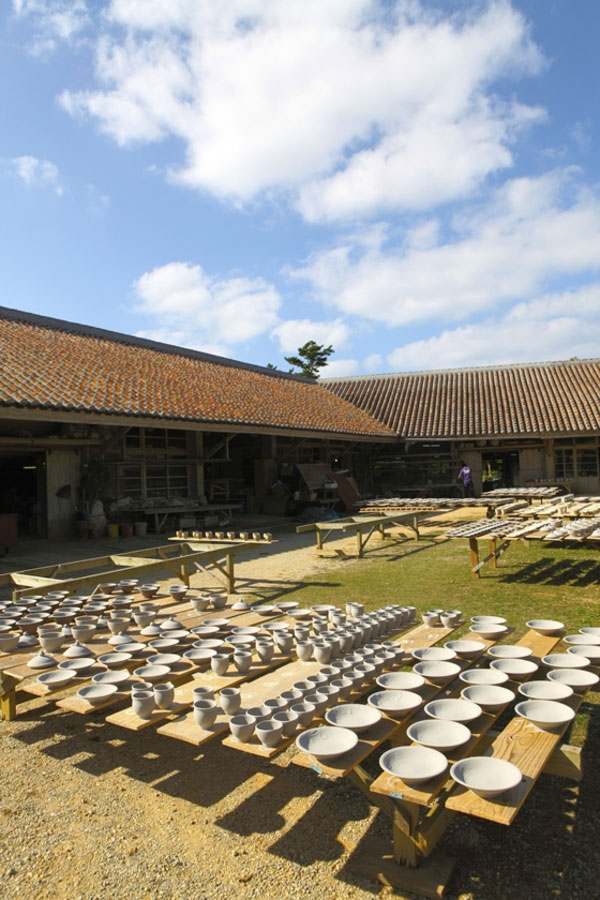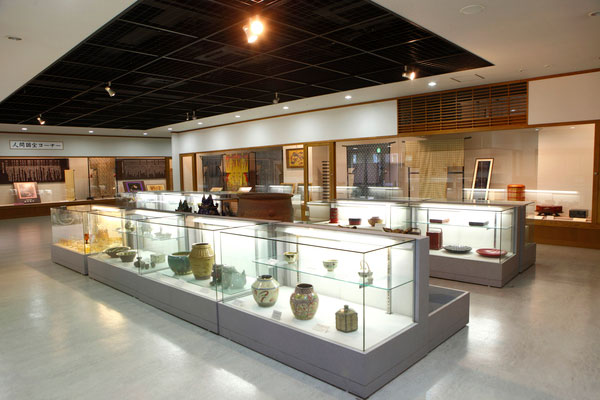
- Ceramic
- Okinawa
Tsuboya ware Tsuboya yaki
Produced in the Southern islands' natural climate
Porcelain masterpieces popular in Okinawa
Description
What is Tsuboya ware ?
Tsuboya ware (called Tsuboya yaki in Japanese) is a form of pottery produced mainly in Tsuboya, city of Naha, Okinawa prefecture. This craft is one of the leading representations of Okinawan pottery (yachimun in the Okinawa dialect). The notable feature of Tsuboya ware is its impressive ceramic decorations with enamel unique to Okinawa. While originally intended for use by common people, the rich decoration and design of Tsuboya ware was introduced and made more widely known during the Taisho period (1912-1926) by Muneyoshi YANAGI, a philosopher and strong proponent of folk art.
Tsuboya ware is divided into two types, known as arayachi and jouyachi. Compared to arayachi, which is a simple style that is mainly used for alcohol or water bottles, jouyachi makes use of various types of enamel and is baked at a high temperature of 1200℃ (about 2192℉). Tsuboya ware baked in this manner have a bulky presence and style that reflect the rich natural features of Okinawa. Among the enamels that are used, white enamel made from slaked lime and unhulled rice ash mixed with Okinawa's gushikami and kina clays, is particularly typical of Tsuboya ware and an important part of its charm.
History
 Photo:Okinawa Convention&Visitors Bureau
Photo:Okinawa Convention&Visitors Bureau
The origin of Okinawa's pottery is said to be Korean roof tiles brought from continental Asia during the 14th to 16th centuries. At this time, Okinawa was the independent Ryukyu Kingdom and enjoyed prosperous trade with China and various countries in Southeast Asia. It is thought that the technique behind arayachi was also transmitted during this period. During the 17th century, the Ryukyu Kingdom fell under the control of the Tokugawa shogunate's (feudal military government) Satsuma domain, and the prosperous trade with foreign countries ended. As a result, Sho Nei, the King of Ryukyu at that time, summoned potters from Korea to open kilns and endorsed actively adopting Korea's pottery production technology. This is how the basis of Tsuboya ware, jouyachi, started being produced in Okinawa. In 1682, the Shuri, Chihana, and Wakuta kilns were combined into one place, what is today known as Tsuboya, and this is the origin of modern-day Tsuboya ware.
Going into the Meiji period (1868-1912), production of Tsuboya ware declined for a while, due to the mass-production of cheap earthenware dominating the market. However, due to the Taisho era (1912-1926) folk craft movement, Tsuboya ware gained recognition and finally in 1985 the potter Jiro KINJO was recognized as the first Living National Treasure in Okinawa prefecture. Living National Treasure is a title bestowed by the government to groups or individuals who possess skills that are indispensible to produce cultural heritage such as traditional crafts or performance traditions like kabuki theater. Tsuboya ware has come to be widely known as a traditional handicraft that represents Okinawa.
Production Process
 Photo:Okinawa Convention&Visitors Bureau
Photo:Okinawa Convention&Visitors Bureau
- 1. Excavation of potter's clay
Red clay (shimajiri mahji) and white clay peculiar to Okinawa is excavated and prepared at a factory in a town called Onnason. Clay is mixed to suit the type of pottery being produced, and filtered and stirred. The clay is then passed through a filter by a pressing machine, the texture of the clay is put in order, and it is then thoroughly kneaded with a kneading machine. Before, clay kneading was difficult and a heavy labor as it was done by hand.
- 2. Casting
Lathe casting is used when producing containers or vases. There are electric lathes and foot-controlled kick lathes. Portable Okinawan liquor containers, sake jugs, and small shisa or Okinawan lion statues are produced using molds. Large Okinawan lion statues are produced with the technique of forming by hand, which makes it possible to create statues with unique facial expressions. Casting with a wooden model is done when producing zushigame jugs, which in ancient times were used in Okinawa to carry ashes of the deceased.
- 3. Engobing
After casting and drying, an engobe (clay slip coating) known as nabu is applied to cover the surface of the red clay. Nabu uses gushitou white clay, unique to Tsuboya ware, dissolved in water. This step produces a piece of a gentle white color with a thickness.
- 4. Decoration
After applying enamel, it is time for the most valuable aspect of Tsuboya ware: decoration. While the enamel is only half-dried, the pottery is line-engraved. Various techniques can be used, like applying fillings to give a thickness similar to that of engraving. A notable feature of Tsuboya ware is its boldly carved patterning on unglazed pottery. Red painting is applied after glaze firing. Red tsuboya ware is particularly prized as a first-class item.
- 5. Overglazing with enamel
Finally, the earthenware is given shine by overglazing with enamel. The overglaze uses raw materials that are typical of Okinawa, such as coral limestone and rice husks. There are also various colors of overglaze that are used depending on the design of the pottery being produced, such as amber, a transparent glaze that uses white clay, or a blackish color.
- 6. Firing
Firing is normally done twice, but for Tsuboya ware, firing is done only once. This is important, as once the fire is lit, it will continue to burn for at least ten hours without stopping. In the past, firing was done in traditional climbing kilns* with firewood being burned, but due to the development of residential areas around Tsuboya and problems regarding smoke pollution, the use of firewood kilns in Tsuboya has been restricted. Today, gas kilns are used for firing. The advantage of a gas kiln is that it is easy to control the temperature and produce a uniform quality. Since potters dedicated to the use of firewood kilns have moved their kilns to the village of Yomitan, the traditions of Tsuboya ware have continued there as well.
*A climbing kiln is an ancient type of pottery kiln brought to Japan from China and Korea and is formed by digging a hole in the hillside.
Facility Information
Naha Traditional Craft Center
 Photo:Okinawa Convention&Visitors Bureau
Photo:Okinawa Convention&Visitors Bureau
-
Address
-
Tel.+81-98-868-7866
-
ClosedWednesdays and December 29 to January 3
-
Business Hours9:30am to 5:30pm
-
Website
Other Ceramic
- Imari ware/Arita ware
- Hasami ware
- Kutani ware
- Mashiko ware
- Shigaraki ware
- Bizen ware
- Hagi ware
- Koishiwara ware
- Mino ware
- Tobe ware
- Tokoname ware
- Karatsu ware
- Kasama ware
- Satsuma ware
- Iga ware
- Mikawachi ware
- Agano ware
- Otani ware
- Obori-soma ware
- Tsuboya ware
- Aizu-hongo ware
- Shodai ware
- Echizen ware
- Akazu ware
- Tamba-tachikui ware
- Yokkaichi-banko ware
- Izushi ware
- Kyo ware/Kiyomizu ware
- Iwami ware
- Amakusa ceramics
- Seto-sometsuke ware
- Sanshu Onigawara Crafts
Other Crafts Made in Okinawa
- Tsuboya ware
- Miyako ramie textile
- Ryukyu lacquerware
- Kumejima tsumugi silk
- Ryukyu traditional resist-dyed textiles
- Chibana-hanaori textiles
- Yaeyama cotton cloth
- Yaeyama ramie cloth
- Shuri brocade
- Yomitanzan-hanaori textiles
- Ryukyu traditional textiles
- Kijoka banana fiber cloth
- Yonaguni brocade
- Yuntanza minsa
- Flower pattern textiles
- Sanshin































































































































































































































































































